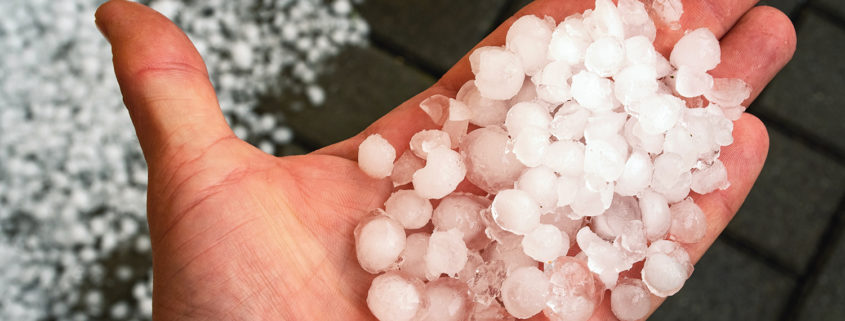Your commercial roof is exposed to the elements all day, every day. It’s designed to sit out in the hot sun, the freezing cold, and endure severe weather. So what happens to your roof when your commercial building experiences a potentially harmful weather event like a hail storm? What does hail damage look like and what should a business owner be aware of? Keep reading to find out how you can take care of your roofing system and keep your commercial property protected!
What are Hailstones?
Hailstones are formed in strong thunderclouds, commonly with powerful updrafts, like those that cause tornadoes. The cloud layer also has to have a temperature of zero degrees Celsius (32 degrees Fahrenheit). The updrafts push water droplets through the cloud. The droplets then freeze and become small ice granules that accumulate more ice as they travel, like layers of an onion.
Hailstones fall to the ground when they become too heavy for the updrafts to keep them aloft. Often, hail-carrying clouds will have a greenish color.
Every country has its own standard for damaging hail, based on the local sensitivity. Certain crop-growing regions could have their yields compromised by very small hailstones. In the United States, destructive hailstones are usually observed measuring between 2.5 centimeters and 4.4 centimeters. Small hailstones are little more than an inconvenience, but large hailstones can cause significant damage to roofs, windows, and automobiles.
Assessing Hail Damage to Your Commercial Roof
Hailstorms are more prevalent in the inner most areas of various continents. So if your commercial building is located in the American Midwest, it’s probably seen its fair share of hailstorms already. If so, you should already be performing roof inspections after any severe weather to check the extent of the damage.
Hail impacts can cause damage to the roof membrane, even if the size of the hail wasn’t considered large enough to be damaging according to weather outlets. In fact, if there was high wind present, even small hailstones can cause significant damage. This damage shortens your roof’s lifespan and can lead to roof leaks and further damage and degradation.
When preparing to inspect your roof, first make sure that any storm danger has already passed. Check for cracks, punctures, or dents in the roofing material that are the telltale signs of damage from hail. Depending on the type of roof material, hail damage could show up as black, white, yellow, or red markings. Metal roofs are especially prone to indentations from hail damage. (If you are not comfortable going up onto the roof for visual inspection, a commercial roofing contractor can easily complete the assessment).
Your insurance policy may not cover dents in a metal roof because some insurance companies consider dents to be cosmetic damage. Even if all that you see are small cracks and dents, don’t assume that it’s just cosmetic damage, especially if your roof is over a decade old.
Most commercial businesses have flat roofs, but if your business has a roof with asphalt shingles, check and see if any of the shingles are loose or missing. Sometimes shingle damage is hard to see and can be better discerned by touching the shingles. When you touch the shingles you will be able to feel places where the rough, sandy coating of the shingle is missing. These are areas where your shingles have been damaged by hailstones.
In addition to the roof itself, you should also inspect any roof-mounted HVAC units for damage or dents. Make sure you take a close look at your gutters, downspouts, coping metal, flashings, and vent covers for any damage. If your building has skylights, check both the skylights and the seals around them for compromised areas.
Take pictures of any damage or suspected damage that you see, even if you’re not sure if it was caused by hail damage. Proper documentation will help you immensely when it comes time to process your insurance claim.
It’s important that you don’t let commercial roof damage go unaddressed. It could lead to even greater problems down the road if your already damaged roof has to bear the impact of another hail storm or long winter season. Once you have determined the presence of damage to your roof, it’s time to take the next step.
Contact your Insurance Company
After you have conducted your roof inspection and determined that there is hail or storm damage, it’s time to contact your insurance company. Your insurance adjuster will also inspect the damage, and determine if your company’s insurance policy will allow for an insurance claim. If so, then your insurance representative can begin the claims process.
It’s important that you start this process as soon as possible, because any delay in the roof repair process could negatively affect your business’s day to day operations. If your roof has a warranty, this is a good time to go over it and see if hail damage is covered.
Keep Your Roof Protected
For the best in commercial roofing services, make sure you’re contacting the most reliable roofing company you can find. Make sure the roofing contractor handles commercial roofs, as well, because they are very different (and subject to different building criteria) than residential roofs. At TEMA Roofing, our decades of experience in the commercial roofing industry gives us the edge when it comes to commercial roof repair.
If you want the ultimate solution in commercial roof maintenance, you can contact us about our Roof Asset Management Program. Having our maintenance program in place means that you’re protected from roof damage and leaks 24 hours a day, 365 days a year. We deal with all types of commercial roofing material – metal, EPDM, and TPO just to name a few. TEMA Roofing can customize a Roof Asset Management Program that fits your business and your budget. Contact us today to get your roof protected!





